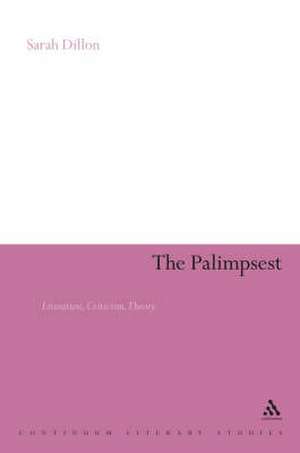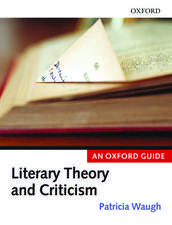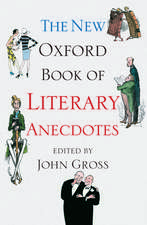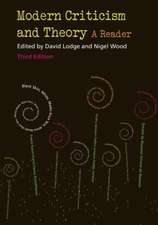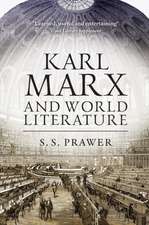The Palimpsest: Literature, Criticism, Theory: Continuum Literary Studies
Autor Dr Sarah Dillonen Limba Engleză Hardback – 24 oct 2007
Drawing together diverse literary, critical and theoretical texts in which the palimpsest has appeared since its inauguration by Thomas De Quincey in 1845, Palimpsest: Literature, Criticism, Theory provides the first ever genealogy of this metaphor. Sarah Dillon's original theorisation argues that the palimpsest has an involuted structure which illuminates and advances modern thought. While demonstrating how this structure refigures concepts such as history, subjectivity, temporality, metaphor, textuality and sexuality, Dillon returns repeatedly to the question of reading. This theorisation is interwoven with close readings of texts by D. H. Lawrence, Arthur Conan Doyle, Umberto Eco, Ian McEwan and H.D.
Clearly written, and negotiating a range of critical theories and modern literary texts, it provides a reference point and critical tool for future employment of the concept of 'palimpsestuousness', and makes a significant contribution to the debate surrounding the relationship between theoretical and critical writing on literature.
| Toate formatele și edițiile | Preț | Express |
|---|---|---|
| Paperback (1) | 255.38 lei 6-8 săpt. | |
| Bloomsbury Publishing – 29 ian 2014 | 255.38 lei 6-8 săpt. | |
| Hardback (1) | 888.81 lei 6-8 săpt. | |
| Bloomsbury Publishing – 24 oct 2007 | 888.81 lei 6-8 săpt. |
Din seria Continuum Literary Studies
- 31%
 Preț: 889.23 lei
Preț: 889.23 lei -
 Preț: 257.03 lei
Preț: 257.03 lei - 23%
 Preț: 255.84 lei
Preț: 255.84 lei - 30%
 Preț: 773.65 lei
Preț: 773.65 lei - 23%
 Preț: 255.76 lei
Preț: 255.76 lei - 22%
 Preț: 889.49 lei
Preț: 889.49 lei - 22%
 Preț: 773.39 lei
Preț: 773.39 lei - 22%
 Preț: 889.49 lei
Preț: 889.49 lei - 13%
 Preț: 256.20 lei
Preț: 256.20 lei - 23%
 Preț: 255.76 lei
Preț: 255.76 lei - 31%
 Preț: 891.51 lei
Preț: 891.51 lei - 22%
 Preț: 889.55 lei
Preț: 889.55 lei - 31%
 Preț: 889.49 lei
Preț: 889.49 lei - 22%
 Preț: 772.65 lei
Preț: 772.65 lei - 22%
 Preț: 889.15 lei
Preț: 889.15 lei - 14%
 Preț: 771.84 lei
Preț: 771.84 lei - 22%
 Preț: 888.50 lei
Preț: 888.50 lei - 22%
 Preț: 772.98 lei
Preț: 772.98 lei - 30%
 Preț: 595.82 lei
Preț: 595.82 lei - 13%
 Preț: 258.59 lei
Preț: 258.59 lei - 22%
 Preț: 889.88 lei
Preț: 889.88 lei - 22%
 Preț: 256.29 lei
Preț: 256.29 lei - 14%
 Preț: 652.81 lei
Preț: 652.81 lei - 31%
 Preț: 889.49 lei
Preț: 889.49 lei - 23%
 Preț: 255.76 lei
Preț: 255.76 lei - 14%
 Preț: 772.17 lei
Preț: 772.17 lei - 31%
 Preț: 771.59 lei
Preț: 771.59 lei - 22%
 Preț: 898.95 lei
Preț: 898.95 lei - 23%
 Preț: 256.02 lei
Preț: 256.02 lei - 31%
 Preț: 889.88 lei
Preț: 889.88 lei - 22%
 Preț: 256.59 lei
Preț: 256.59 lei - 22%
 Preț: 886.21 lei
Preț: 886.21 lei - 31%
 Preț: 772.58 lei
Preț: 772.58 lei - 31%
 Preț: 889.08 lei
Preț: 889.08 lei - 30%
 Preț: 774.46 lei
Preț: 774.46 lei - 31%
 Preț: 889.97 lei
Preț: 889.97 lei - 23%
 Preț: 254.84 lei
Preț: 254.84 lei - 28%
 Preț: 373.89 lei
Preț: 373.89 lei - 30%
 Preț: 774.20 lei
Preț: 774.20 lei - 31%
 Preț: 888.50 lei
Preț: 888.50 lei - 22%
 Preț: 889.63 lei
Preț: 889.63 lei - 31%
 Preț: 890.14 lei
Preț: 890.14 lei - 22%
 Preț: 888.50 lei
Preț: 888.50 lei - 22%
 Preț: 888.65 lei
Preț: 888.65 lei - 23%
 Preț: 262.25 lei
Preț: 262.25 lei
Preț: 888.81 lei
Preț vechi: 1140.06 lei
-22% Nou
170.08€ • 177.93$ • 141.28£
Carte tipărită la comandă
Livrare economică 02-16 aprilie
Specificații
ISBN-10: 0826495451
Pagini: 176
Dimensiuni: 156 x 234 x 19 mm
Greutate: 0.42 kg
Editura: Bloomsbury Publishing
Colecția Continuum
Seria Continuum Literary Studies
Locul publicării:London, United Kingdom
Descriere
Caracteristici
Notă biografică
Cuprins
Recenzii
"Her chapters focus on a number of literary figures...but there is also a detailed account of the ways in which the palimpsestic - or 'palimpsestuous' - nature of Ian McEwan's Atonement affects our reading of that novel. Strengthening her meticulous analyses of individual texts are the equally detailed complementary readings. The Palimpsest manages to be that rare thing: a work of criticism that remains rigidly focused upon - and loyal to - its subject matter, without ever being afraid to draw on a wide range of different authors and disciplines to explore the significance of its one central metaphor."Modern Language Review, February 2009
'a tour de force of twentieth-century theory as well as an adventure in reading' - Forum for Modern Language Studies, May 21 2009
"Dillon engages wittily and at times brilliantly with Thomas De Quincey, D. H. Lawrence, Arthur Conan Doyle, Umberto Eco, Ian McEwan and H. D. . . . [her] innovative work fills a cognitive gap by drawing together the history and theory of palimpsests and beginning to investigate how this fascinating concept can inform our understanding of literature. This book is a worthy rival to Gérard Genette Palimpsests (1997) (first published in French as Palimpsestes (1982)) and lays a foundation stone for further studies of the palimpsestuous quality of literature." - The Review of English Studies, New Series, Vol. 60, No. 244, Christopher Whalen 2008
"Dillon's book is very reader-friendly, witty and entertaining, which makes it approachable for both specialists and non-specialists alike...The Palimpsest is an excellent and significant work contributing to the discussion about the interconnecting roles of critical and theoretical writing that pushes beyond the boundaries of traditional clear-cut criticism. Dillon's work thus serves as a good reference point for future engagements with the paradigm of the palimpsest."Anglistik: International Journal of English Studies, September 2009
"...a fascinating history of the palimpsest which contextualises precisely why Dillon finds them so relevant for contemporary thinking, the book couples literature and theory in each chapter...a tour de force of twentieth-century theory as well as an adventure in reading which focuses refreshingly on literature not so usually in the literary headlights."Forum for Modern Language Studies, Vol 45 No.4
Briefly reviewed in the Year's work in English Studies journal, vol 89, No. 1 'Dillon's work explores the palimpsest metaphor through examining its history, its use by De Quincey, D.H. Lawrence, Arthur Conan Doyle, Umberto Eco, H.D., Ian McEwan and others'
